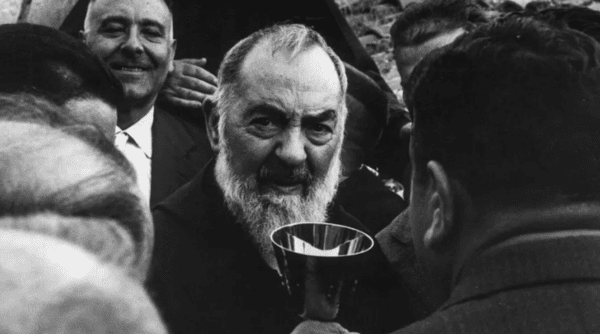A Reflection from “Padre Pio and You” by Mary O’Regan
Pio’s First Spiritual Daughter
On a frigid day in January 1904, Pio left Morcone for the Friary of St. Francis of Assisi in the woodsy hamlet of Sant’Elia a Pianisi. Sant’Elia, with its medieval castle ruins and preserved thirteenth-century church, had been a stomping ground for royals down through the centuries, giving it the feel of having an ancient history.
Br. Pio and Br. Anastasio traveled barefoot and arrived frozen with cold. They were ushered in and sent before the fireplace to thaw. The next day, Pio was given his first pair of sandals and thus he began six years of study to become an ordained friar. Pio was to do the rounds of several friaries and take the courses that each seminary offered. His studies included philosophy, Sacred Scripture, theology, logic, canon law and the Rule of St. Francis, which he knew in forensic detail even before he was taught it at length. His years in seminary were not to be nearly as dramatic as his later years, as he was being given special graces of protection from temptation and distraction to make it to ordination. He was known as exemplary, but not as extraordinary; he didn’t arouse intense curiosity and certainly did not invite celebrity, which meant he could be formed in the mold of St. Francis in peace and privacy. He did, however, graduate to a new level in the spiritual life, when he was granted the ability to bilocate.
A Gift of Bilocation
Pio was only seventeen when he bilocated—was present in two places at once—for the first time, and he was himself totally confounded at what was happening to him.
The first time it happened, on January 18, 1905, Pio was in the stone chapel, kneeling next to Br. Anastasio, both of them lost in prayer like angels before the throne of God. Then, in two shakes of a lamb’s tail, Pio found himself transported hundreds of miles away to Udine, in the northernmost part of Italy, the very rim of Italy’s boot. Pio was in the South of Italy and the North at the same time.
It was a gloomy winter night, and he found himself in the halls of a beautiful palace of a noble family. He had gone from the austerity of the friary to a place of royalty and opulence. Our Lady appeared beside Pio, which was no surprise because he saw her every day, and she said, “You see in that room a man is dying? He is the head of the family. He is saved through the prayers and tears of his wife, and by my intercession.” She instructed Pio, “Pray for him,” and then Pio went near the dying man and, obeying Our Lady without question, he prayed with all his soul for the dying man.
Pio prayed behind the man’s wife, who wept bitter tears. The wife, Leonilde, was heavily pregnant and dressed in a grand black Victorian dress that swept the floor and had a high neck. She did not know she was about to give birth to Pio’s first spiritual daughter that same night and she sobbed her heart out, not so much because her husband was about to die, but because she feared he would lose his soul. Her husband, Giovanni, had been a diehard Freemason. And his fellow Masons were patrolling the palace gates. A priest was there, too, but so determined were the Masons that Giovanni was not to be shriven and receive the last rites, they prevented the man of God from entering.
Leonilde did not know that the Virgin Mary was there and had led Padre Pio in praying for Giovanni. But unexpectedly, Leonilde saw Pio leave the room. She called out to him, but he vanished from her sight. Suddenly she heard their dog howl mournfully as he sensed his master was dying. Not able to bear the constant yowling of the dog, Leonilde went outside to calm the pet, but no sooner had she done so than she went into labor! One of her menservants helped deliver the baby, and with her newborn baby girl in her puffy-sleeved arms, she returned to her dying husband. The same servant who helped Leonilde give birth saw an opening and courageously he walked up to the Masons and advocated, “Let the priest enter. You can stop him from assisting the dying man, but you have no right to prevent him from baptizing the little baby.” The Masons relented and let the priest through the gates; he rushed to the dying man and administered Extreme Unction. Giovanni died with a prayer on his lips that beseeched God’s pardon. The priest then hastily baptized the newborn baby girl, named Giovanna after her dad.
Our Lady informed Pio that Giovanna was his first spiritual daughter. “I entrust this creature to you,” she told him. “She is a precious stone still in a rough state. Work on her, polish her, render her as brilliant as possible, because one day I wish to adorn myself with her.”
Pio was perplexed. “How is this possible?” he asked. “How can I take care of this child when I am so far away?” Our Lady replied mysteriously, “It is she who will come to you, but first of all you will meet her in St Peter’s.” With that Padre Pio found himself back in the chapel in the click of a finger. He had never left the seminary, yet he had also been in the palace where Giovanna was born. In time he would become used to bilocating all over the world, including to places as far as Hawaii, but during all these mystical trips, he never once left his native Italy!
+
This article on the St. Pio’s first spiritual daughter is adapted from the book Padre Pio and You by Mary O’Regan which is available from Sophia Institute Press.
Art for this post on a reflection from Padre Pio and You: cover used with permission; Photo used in accordance with Fair Use practices.





